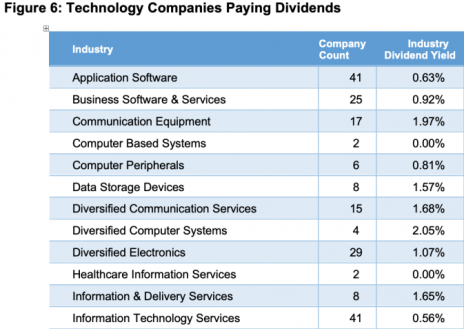Here I want to address an important strategy that has long been a favorite of investors, especially in their golden years—Dividend Investing.
For many decades, dividends were mostly paid by blue chip, financially-healthy, conservative companies—just the types of stocks that are attractive to retired investors who don’t want to take on excess risk but love the cash flow inherent to dividend-paying stocks.
It was rare to see a high-growth company issuing dividends, other than Intel (INTC), who began paying them in 1992. The tech boom and bust of the early 2000s scared a lot of investors away from technology companies, so many of the more established tech companies decided a dividend strategy was one way to lure them back. Microsoft (MSFT) began paying dividends in 2003; Cisco (CSCO) followed in 2011, and now, as you can see by the following chart (Figure 6), many tech companies pay a dividend.
The average dividend yield (annual dividend divided by the current stock price) for companies in these tech sectors is 1.22%, significantly below the 1.91% average for the companies in the S&P 500 index. Currently, some 81.4% of the companies in the index pay a dividend.
Consequently, it’s not unusual for growth as well as value companies to pay some sort of dividend—especially if they’ve been around for a while. But it is rare to find a company in a high-growth stage, such as a start-up technology or cutting-edge biotech firm, that is paying dividends at all.
But many savvy, long-term investors realize dividend investing is a great method to not only build extra appreciation into your portfolio, but also a successful strategy for keeping risk down during uncertain economic and market cycles.
During volatile periods, investors often flock to dividend-paying stocks as a way to create cash flow in their portfolios, as well as to take advantage of their more stable characteristics which may help to mitigate any losses from more speculative stocks that may decline precipitously.
Dividend Reinvesting
Another advantage of buying stocks that pay dividends is their compounding effect if you reinvest the dividends, rather than cashing them out as they are paid.
Here’s one example:
“Let’s say you own 100 shares of a $40 stock with a 2.5% yield. That means the company pays $1.00 per share in dividends each year, or 25 cents per quarter. This table (Figure 7) shows how your dividend income and the size of your investment will change over the first year.
“As you can see, reinvesting that first $25 increases your second dividend payment by 16 cents, because you now own another $25 worth of dividend-paying stock.
“By the end of the year, your quarterly dividends have increased to $25.47, and the value of your investment has increased by $100.94—that $100 is simply the dividend payments, which you would have earned whether or not you chose to reinvest. But the extra 94 cents is “dividends on dividends,” which you earned thanks to reinvesting.”
That’s just a small example of the effects of dividend reinvesting. It’s like free money! And often, companies increase their dividends, which puts even more money in your pocket. In fact, total dividend payouts globally are expected to reach nearly $1.4 trillion this year, just 3% below their pre-pandemic peak.
According to www.DividendInvestor.com, more than 1,100 companies and closed-end funds offer Dividend Reinvestment Plans (DRIPs). A DRIP allows you to automatically reinvest cash dividends by purchasing additional shares or fractional shares on the dividend payment date.
Companies who operate their own DRIPs will often let you buy additional shares of their stock commission-free, and sometimes even at a discount to the current share price. In my Wall Street’s Best newsletters, I follow two investment pros who keep a close eye on dividend reinvestment plans—Charles A. Carlson, editor of DRIP Investor and Vita Nelson, editor of DirectInvesting.com. Each month, they offer great insight into the DRIP industry, as well as a selection of recommended stocks.
DRIPs are often recommended for long-term investors. Buying and selling shares in a DRIP is not as easy as picking up the phone and calling your broker. Most companies buy and sell shares in a DRIP in bulk (to reduce transaction fees), so you are most likely not going to get current market prices. It may take a few days to get in or out, so if you tend to trade stocks, a DRIP would not be your best investing vehicle.
But DRIPs are a great way to invest in well-managed, financially stable companies—for the long term. When my nieces and nephew were born, I set up DRIPs for them, buying stock in McDonald’s (MCD). They didn’t get rich from the DRIP, but when they set off for college, they had a tidy little sum to use for buying some of the extras they needed.
My hope was that discussing their shares with them through the years would turn them on to investing for life. Alas, that didn’t exactly happen. However, I can report that they were thrilled with the McDonald’s coupons that came with the annual company report each year!
DRIP investing is just one type of concentrated dividend investing.




